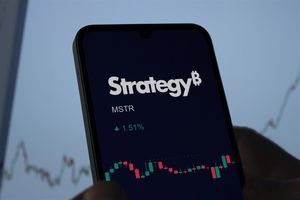
New York, NY – November 11, 2025 – Investor optimism surged across Wall Street today as the Dow Jones Industrial Average (DJIA) closed at an unprecedented all-time high, propelled by the long-awaited resolution of a 41-day U.S. government shutdown. The monumental close marks a significant "relief rally" that has swept through financial markets, signaling a renewed confidence in economic stability and political functionality after weeks of fiscal uncertainty.
The breakthrough in Washington has ignited a powerful bullish sentiment, with major indices recouping recent losses and setting new benchmarks. This robust market performance underscores the deep-seated resilience of the American economy, even in the face of political gridlock, and reflects an underlying strength cultivated throughout 2025 by technological advancements and strategic monetary policy.
Detailed Coverage of the Fiscal Impasse and Market's Triumphant Return
The United States federal government endured its longest shutdown in history, a grueling 41-day period stretching from October 1, 2025, to early November 2025. This fiscal impasse was rooted in profound partisan divisions, primarily concerning the extension of expiring healthcare tax credits under the Affordable Care Act (ACA). Senate Democrats staunchly advocated for these extensions, a demand that clashed directly with Republican appropriations proposals, leading to a prolonged deadlock that paralyzed federal agencies and cast a shadow of uncertainty over the nation's economic outlook.
The extended shutdown had tangible economic consequences, delaying the release of critical economic data and dampening both consumer and business sentiment. Estimates from the Congressional Budget Office (CBO) suggested that the shutdown could have reduced annualized GDP growth in the final three months of 2025 by 1 to 2 percentage points, leading to permanent economic losses if left unresolved. The uncertainty created a cautious environment for investors, who closely watched developments from Capitol Hill.
A pivotal turning point arrived on Sunday, November 10, 2025, when news broke of substantial progress towards a resolution. The Senate successfully advanced a crucial funding bill aimed at reopening federal agencies, with strong indications that President Donald Trump was prepared to sign it into law. This breakthrough immediately triggered widespread optimism across global financial markets, leading to a palpable sense of relief that quickly translated into significant market gains.
The "relief rally" commenced with vigor on Monday, November 10, as major U.S. stock indexes surged. The S&P 500 climbed 1.5%, the Dow Jones Industrial Average gained 0.8%, and the tech-heavy Nasdaq Composite jumped 2.3%. This surge was attributed to a significant reduction in political uncertainty, the anticipated restoration of critical public services, and an expected improvement in consumer sentiment. Investors expressed optimism that the resolution would provide access to official economic data, offering much-needed clarity on the Federal Reserve's future outlook. The positive momentum culminated today, Tuesday, November 11, 2025, with the Dow Jones Industrial Average (DJIA) rallying to close at a fresh record high of 47,927.96 points, marking its 16th record close for the year and signaling a robust wave of investor confidence.
Companies Poised to Win and Lose in the Wake of Renewed Optimism
The end of the government shutdown and the ensuing market rally will undoubtedly create a landscape of winners and losers, with various sectors experiencing different impacts. Companies with significant government contracts, such as defense contractors like Lockheed Martin (NYSE: LMT) and Raytheon Technologies (NYSE: RTX), or IT service providers to federal agencies, which faced payment delays or project halts during the shutdown, are now poised for a strong rebound as funding flows resume. Their operations can normalize, and delayed projects can move forward, restoring revenue streams.
Sectors highly sensitive to consumer sentiment and economic stability, such as retail and hospitality, are also likely to benefit. Consumers, no longer facing the specter of economic disruption from a prolonged shutdown, may feel more confident in spending. Companies like Marriott International (NASDAQ: MAR) or Starbucks (NASDAQ: SBUX) could see an uptick in activity as discretionary spending recovers. Furthermore, financial institutions, including major banks like JPMorgan Chase (NYSE: JPM) and Bank of America (NYSE: BAC), tend to thrive in periods of market stability and investor confidence, benefiting from increased trading volumes and a more predictable economic environment. The resolution also provides clarity on regulatory landscapes, which is crucial for their long-term planning.
Conversely, while the overall market is up, some shifts could occur. The tech-heavy Nasdaq Composite experienced a slight dip on November 11, as investors rotated out of some high-growth technology stocks. This suggests a potential reallocation of capital towards broader, more value-oriented sectors that were previously overlooked or undervalued during the shutdown uncertainty. While companies like NVIDIA (NASDAQ: NVDA) and Microsoft (NASDAQ: MSFT) have seen tremendous growth fueled by artificial intelligence (AI) optimism throughout 2025, the market's current move might indicate a broadening of investment interest beyond the concentrated AI sector, potentially moderating their rapid ascent in the very short term as funds diversify.
The healthcare sector, specifically companies involved in the Affordable Care Act's ecosystem, might face continued scrutiny or adjustments depending on the specifics of the legislative compromise. While the immediate crisis is averted, the underlying political disagreements over healthcare tax credits could resurface, creating ongoing policy uncertainty for insurers like UnitedHealth Group (NYSE: UNH) or pharmaceutical companies. However, the overall stability brought by the shutdown's end will likely outweigh these sectoral specific concerns for most market participants, leading to a net positive outlook.
Wider Significance and Historical Context
The resolution of the 41-day government shutdown and the subsequent market euphoria carry a wider significance beyond immediate financial gains. This event underscores the profound sensitivity of financial markets to political stability and fiscal predictability. In an increasingly interconnected global economy, domestic political gridlock can have far-reaching ripple effects, impacting international trade, investor confidence, and the perceived reliability of the U.S. as a global economic anchor. The swift market rebound illustrates how quickly capital can flow back into assets when perceived risks—especially political ones—are mitigated.
This episode fits into a broader industry trend where geopolitical and domestic policy risks are increasingly factored into market valuations. While strong corporate earnings and technological innovation (particularly in AI) have been powerful drivers of market performance throughout 2025, political stability acts as a critical foundational layer. When this layer is compromised, even robust underlying fundamentals can be overshadowed by uncertainty. The resolution now allows market participants to refocus on economic data, corporate performance, and the Federal Reserve's monetary policy, rather than being distracted by legislative battles.
Regulatory and policy implications are also significant. The prolonged shutdown highlighted vulnerabilities in federal agencies' ability to function, impacting everything from economic data collection to public services. The experience may prompt future discussions on mechanisms to prevent or shorten such impasses, potentially leading to reforms in budget processes or congressional rules. For example, the disruption to federal loan programs or permit approvals during the shutdown could spur calls for more resilient government operations, regardless of political disagreements.
Historically, U.S. government shutdowns have typically led to temporary market dips followed by recoveries once the impasse is resolved. The 2013 shutdown, for instance, saw a brief market decline before a recovery. The 2018-2019 shutdown, though shorter than the recent one, also demonstrated the market's ability to bounce back. However, the 41-day duration of this recent shutdown, coupled with its specific focus on critical healthcare legislation, made it a more significant test of market resilience. The current rally, particularly the Dow's record-breaking performance, suggests that investors viewed this resolution as a strong affirmation of the U.S. economy's ability to overcome political hurdles, perhaps even more so than in previous instances.
What Comes Next: Navigating the Post-Shutdown Landscape
In the short term, the market is likely to experience continued positive momentum as the "relief rally" fully plays out. Investors will now eagerly await the release of delayed economic data, which will provide a clearer picture of the economy's health and offer crucial insights for the Federal Reserve's upcoming monetary policy decisions. There's an expectation that the Fed, having already cut rates by 25 basis points in October to 3.75%-4%, might consider further easing by year-end 2025 or early 2026, which would further bolster market sentiment. The immediate focus will also shift to corporate earnings reports for the current quarter, which will reveal how companies weathered the shutdown period and what their forward guidance looks like.
Looking further ahead, the long-term possibilities are tied to whether the underlying political divisions that led to this shutdown can be genuinely addressed or if they merely represent a temporary truce. While the immediate crisis is over, the deep partisan rifts, particularly concerning healthcare funding, remain. This could lead to recurring fiscal battles in the future, creating intermittent periods of uncertainty. Companies will need to consider strategic adaptations, such as building greater resilience into their supply chains and operational models to better withstand potential future government disruptions.
Market opportunities may emerge in sectors that are set to benefit most from renewed government spending and stability, such as infrastructure, defense, and potentially healthcare innovation, depending on future legislative priorities. Challenges, however, include persistent inflation and elevated valuations in certain market segments, especially in the concentrated AI sector. Investors will need to carefully assess individual company fundamentals rather than relying solely on broad market sentiment. Potential scenarios range from a sustained period of economic growth fueled by stability and continued technological advancement, to renewed political volatility that could temper market enthusiasm.
Comprehensive Wrap-Up: A Resilient Market Faces Forward
The resolution of the 41-day government shutdown and the subsequent soaring of the Dow Jones Industrial Average to an all-time high represent a critical turning point for U.S. financial markets. The key takeaway is the profound resilience of the market and investor confidence in the face of significant political headwinds. The rapid rebound underscores that while political stability is highly valued, the underlying strength of the American economy, driven by innovation, strong corporate earnings, and supportive monetary policy, can ultimately prevail.
Moving forward, the market assessment remains cautiously optimistic. While the immediate threat of a shutdown has passed, investors will be vigilant for any signs of renewed political discord. The lasting impact of this period of investor optimism will depend on sustained economic growth, manageable inflation, and a continued commitment to pro-growth policies. The record-breaking performance of the Dow serves as a powerful symbol of recovery and a testament to the market's ability to absorb and overcome adversity.
Investors should closely watch for several key indicators in the coming months. The release of comprehensive economic data will be paramount, providing clarity on the shutdown's actual economic cost and the pace of recovery. Corporate earnings reports will offer specific insights into how individual companies are performing. Additionally, any further actions or guidance from the Federal Reserve regarding interest rates will be crucial. Finally, the political landscape in Washington will remain a significant factor, as the market will be sensitive to any indications of future fiscal stability or renewed legislative battles. The current moment is one of triumph for market bulls, but the path ahead, while brighter, still requires careful navigation.
This content is intended for informational purposes only and is not financial advice





